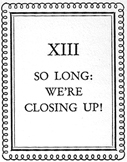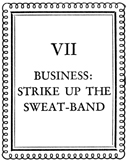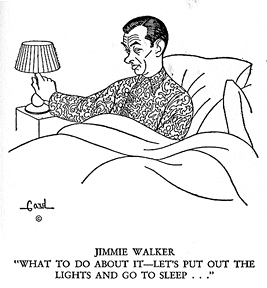Tag: Renee Carroll
In Your Hat, pt. 13
She was wrong, of course. Hats have fallen mostly out of favor (though some of us still wear them), and many restaurants today don’t even offer a coat check service. But, for the most part, hats hung in there long enough for Ms. Carroll.
If you read to the end of this brief closing chapter, you’ll find some updates from throughout Ms. Carroll’s life, written in 1947 and 1951.

In Your Hat, pt. 10

In Your Hat, pt. 8
Here’s Chapter 8 of In Your Hat, the 1933 tell-all memoir by Hat Check Girl to the Stars, Renee Carroll, in which she shares tales of by the many celebrities she encountered while working at Sardi’s, among them George Burns and Gracie Allen, Eddie Cantor, George Jessel, Norma Talmadge, George Raft, Wallace Reid, Ginger Rogers, Douglas Fairbanks, and many more.

A STOOGE, in Broadway parlance, is the assist in the act. If you do an accordion routine and a heckler is paid by you to annoy your act from the box, then you’re probably Phil Baker and your stooge eventually becomes as famous as you are. Witness Sid Silvers of Take a Chance fame.
Broadway is full of stooges, both in real life and on the stage. It may sound strange to you but the jester in the king’s court from the time of The Erl King (I don’t know why they insist on spelling Oil as Erl) has been brought down the years until now he is labeled “stooge.” His job is to take he hard knocks, furnish the opportunity for the gag to be sprung, and appear the perfect fool.
When Phil Baker, who pumps a mean accordion, opened in a show in New York and had a stooge in the box doing the regular routine, Al Boasberg, the gagman who writes funny lines for a dozen or more comedians, wired Baker:
| LIKED YOUR ACT STOP THE OLD GENT WITH THE ACCORDION WAS GOOD TOO. |
Gracie Allen, of the famous team of Burns and Allen, is the stooge of the act, even though it is she who pulls all the funny lines. Recently she gave George Burns cause to laugh when she came to him with an idea.
“Georgie, dear,” Gracie said. “I have an idea.”
“Well, let’s forget it,” George answered characteristically, knowing it would bring on the usual headache.
“I’ve thought of a line for our act,” she continued.
“All right,” gave in George. “What is it?”
“I can’t tell you until I’ve gotten a prop.”
“What sort of a prop?”
“A muff.”
“What’s a muff?” George wanted to know.
“It’s one of those things women used to carry around so that they could hold hands with themselves.”
“All right, Gracie, get yourself a muff and let’s have the gag.”
She went to the best furrier on the Avenue and ordered a muff made. It has to be matched sables, four skins, exquisitely sewn. The muff cost $250 and she charged it to Geroge Burns, her husband. She brought it to him one day.
 “Here’s the muff, George.”
“Here’s the muff, George.”He examined it carefully. He approved.
“I got it at a bargain, George.”
George immediately became suspicious.
“How much, Gracie? How much?” he pleaded.
“Well—er—two hundred and—er—fifty dollars.”
George felt around for support.
“Two hundred and fifty smackers for that thing? Gracie, you’ll ruin me!”
“But it’s a bargain, George, and the furrier let me have it at that price because there are two holes in it!”
And she held up the muff to show him the holes in which one is supposed to insert one’s hands. Burns was nonplused.
“But what about the gag?” he wanted to know. “Is the gag worth $250?”
“Why, George,” giggled the she-stooge, “I just did it. You see, I come on with this muff and you ask me how much I paid for it and I say: ‘I got it at a bargain because it had two holes in it.”
With which Mr. Burns fainted dead away. And that’s how jokes are born in case you’re interested.
Read More »
In Your Hat, pt. 7
Here’s Chapter 7 of In Your Hat, the 1933 tell-all memoir by Hat Check Girl to the Stars, Renee Carroll, in which she reflects on the early days of Sardi’s and how Vincent Sardi came to use the now-familiar caricatures of celebrities to garner attention for his eatery.

IT’S surprising what you can learn from hats. There’s something about the way a man wears one that betrays him instantly. He may smile and joke and think he’s fooling the world—but just by watching him when he saunters or hurries up to my window, I can tell him things that ought to get me a tabloid columnist’s job. I can tell when he’s out of work, and when he’s in the money. When he’s playing the market and winning—and when he’s losing. And there’s nothing pseudo-psychic about it! Just observation—and experience.
Take right at the moment when this ‘umble tome was being concocted. Broadway had been pretty hard hit, and there were hundreds of good actors as well as hams out of work. People who never tipped me less than a quarter before, now fumblingly left only dimes. And apologies were frequent, until I told the hardluckers that there were plenty in the same boat with them. Then, every once in a while, one of the new dime tippers would toss me a dollar bill and say nothing. I knew the answer. He’d landed a job! He was in the dough again.
But it wasn’t all so simple five years ago when I started on this job, the day that Sardi’s opened. I didn’t know a soul among the big-timers, could barely recognize a few of them. The job had been a sort of birthday present to me, and that first day I was awfully scared—and terribly anxious to succeed. I never dreamed that I’d stick at it five years—and then want to keep it fifty more!
Five years! It isn’t much when you say i fast—but a lot of things have happened since then. When Sardi’s opened, there weren’t any Broadway columnists, and a man’s biological secrets were his own. There weren’t any talkies, and the blonde and beautiful Tillie Awnertz could murder the king’s English without having to worry about losing her dear public. There weren’t even any nasal crooners—most of them were in college or short pants. Five years!
A lot of kids of my own generation were just getting their first foothold in show business and thought they were lucky to be able to afford Sardi’s eighty-five cent luncheon. Today some of them are way up on top and never dream of going upstairs for cheaper food, or even looking at the price list when they order their daily delicacies.
A Night in Spain was running at the Schubert Theatre just across the street, and Phil Baker, Ted Healy and Helen Kane were getting their first big chance. Today Baker and Healy are headliners, and Helen Kane has gained fame, fortune, notoriety and considerable poundage. She was getting fifty bucks a week then—now she gets over two thousand and works when she feels like it!
 Robert Montgomery was an adorable young juvenile who owed money to everyone in town and who frequently ate at Sardi’s on the cuff. He was trying frantically to woo and win the lovely Elizabeth Allen who was playing the lead in Broadway, but no one ever thought Bob would get her because it was doubtful if he could even pay for the license and ring. Today they’re happily married, Robert Montgomery is a screen name to conjure with, and his weekly pay check runs ever so high. And millions of movie fans find him every bit as charming as I did in the days “when.”
Robert Montgomery was an adorable young juvenile who owed money to everyone in town and who frequently ate at Sardi’s on the cuff. He was trying frantically to woo and win the lovely Elizabeth Allen who was playing the lead in Broadway, but no one ever thought Bob would get her because it was doubtful if he could even pay for the license and ring. Today they’re happily married, Robert Montgomery is a screen name to conjure with, and his weekly pay check runs ever so high. And millions of movie fans find him every bit as charming as I did in the days “when.”
Those first days at Sardi’s were a lot of fun—and a lot of worry too. There wasn’t a great amount of business, the restaurant was big, and the “nut” high. Like every café owner, Sardi wanted his establishment to be a rendezvous of-and-for celebrities. The little place near the Lambs Club had whetted his appetite for Big Names, and Sardi hungered to repeat his success on a larger scale.
We were talking about the disheartening business one day when things were particularly slack, and Sardi began to reminisce about famous Continental restaurants. Somehow the conversation swung around to Joe Zelli’s in Paris.
“Zelli’s is wonderful,” exclaimed Sardi. “No one would ever dream of seeing Paris without spending at least one evening in Zelli’s. It’s the rendezvous of all the celebrities. I guess they go there because their caricatures hang on the wall.
Read More »



